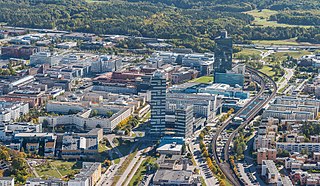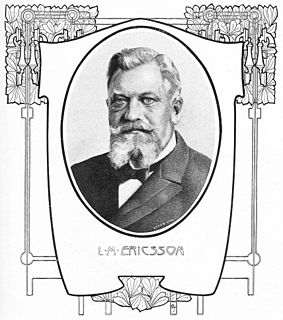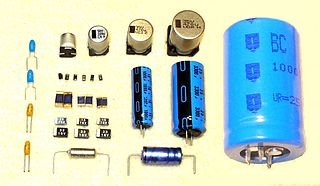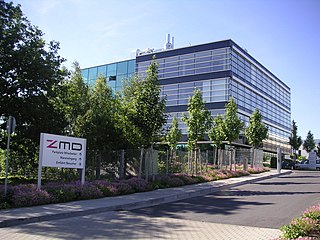
Telefonaktiebolaget LM Ericsson, commonly known as Ericsson, is a Swedish multinational networking and telecommunications company headquartered in Stockholm. The company sells infrastructure, software, and services in information and communications technology for telecommunications service providers and enterprises, including, among others, 3G, 4G, and 5G equipment, and Internet Protocol (IP) and optical transport systems. The company employs around 100,000 people and operates in more than 180 countries. Ericsson has over 57,000 granted patents.

An integrated circuit or monolithic integrated circuit is a set of electronic circuits on one small flat piece of semiconductor material, usually silicon. Large numbers of tiny MOSFETs integrate into a small chip. This results in circuits that are orders of magnitude smaller, faster, and less expensive than those constructed of discrete electronic components. The IC's mass production capability, reliability, and building-block approach to integrated circuit design has ensured the rapid adoption of standardized ICs in place of designs using discrete transistors. ICs are now used in virtually all electronic equipment and have revolutionized the world of electronics. Computers, mobile phones and other home appliances are now inextricable parts of the structure of modern societies, made possible by the small size and low cost of ICs such as modern computer processors and microcontrollers.

Kista is a district in the borough of Rinkeby-Kista, Stockholm, Sweden. It has a strategic position located in between Sweden's main airport, the Stockholm-Arlanda International Airport and central Stockholm, and alongside the main national highway E4 economic artery. Kista comprises residential and commercial areas, the latter in the highly technological telecommunication and information technology industry. There are large research efforts in this entire area, which therefore is dubbed Kista Science City. It is the research park of KTH Royal Institute of Technology.

Lars Magnus Ericsson was a Swedish inventor, entrepreneur and founder of telephone equipment manufacturer Ericsson.
Microelectronics is a subfield of electronics. As the name suggests, microelectronics relates to the study and manufacture of very small electronic designs and components. Usually, but not always, this means micrometre-scale or smaller. These devices are typically made from semiconductor materials. Many components of normal electronic design are available in a microelectronic equivalent. These include transistors, capacitors, inductors, resistors, diodes and (naturally) insulators and conductors can all be found in microelectronic devices. Unique wiring techniques such as wire bonding are also often used in microelectronics because of the unusually small size of the components, leads and pads. This technique requires specialized equipment and is expensive.
National Semiconductor was an American semiconductor manufacturer which specialized in analog devices and subsystems, formerly with headquarters in Santa Clara, California. The company produced power management integrated circuits, display drivers, audio and operational amplifiers, communication interface products and data conversion solutions. National's key markets included wireless handsets, displays and a variety of broad electronics markets, including medical, automotive, industrial and test and measurement applications.

An electrolytic capacitor is a polarized capacitor whose anode or positive plate is made of a metal that forms an insulating oxide layer through anodization. This oxide layer acts as the dielectric of the capacitor. A solid, liquid, or gel electrolyte covers the surface of this oxide layer, serving as the cathode or negative plate of the capacitor. Due to their very thin dielectric oxide layer and enlarged anode surface, electrolytic capacitors have a much higher capacitance-voltage (CV) product per unit volume than ceramic capacitors or film capacitors, and so can have large capacitance values. There are three families of electrolytic capacitor: aluminum electrolytic capacitors, tantalum electrolytic capacitors, and niobium electrolytic capacitors.
Fabless manufacturing is the design and sale of hardware devices and semiconductor chips while outsourcing their fabrication to a specialized manufacturer called a semiconductor foundry. These foundries are typically, but not exclusively, located in the United States, China, and Taiwan. Fabless companies can benefit from lower capital costs while concentrating their research and development resources on the end market. Some fabless companies and pure play foundries may offer integrated-circuit design services to third parties.
An integrated device manufacturer (IDM) is a semiconductor company which designs, manufactures, and sells integrated circuit (IC) products.

Zentrum Mikroelektronik Dresden (ZMD) was regarded as the heart of East Germany's microelectronics research in the 1980s as well as its most advanced integrated circuit manufacturer. Together with TU Dresden and VEB Spurenmetalle Freiberg, ZMD formed the foundation for Silicon Saxony, a cluster of microelectronics companies that came to include new fabs by Siemens and AMD.

Vishay Intertechnology, Inc. is an American manufacturer of discrete semiconductors and passive electronic components founded by Polish-born businessman Felix Zandman. Vishay has manufacturing plants in Israel, Asia, Europe, and the Americas where it produces rectifiers, diodes, MOSFETs, optoelectronics, selected integrated circuits, resistors, capacitors, and inductors. Vishay Intertechnology revenues for 2021 were $3.24 billion. As of December 31, 2021, Vishay Intertechnology had approximately 22,800 full-time employees.

Televerket was a Swedish State authority acting as a state-owned corporation, responsible for telecommunications in Sweden from 1853 until 1993. Originally it was named Kongl. Elektriska Telegraf-Werket, which was founded in 1853. Its name changed to Kongl. Telegrafverket in 1871, Kungl. Telegrafverket in 1903, the prefix Kungl. was dropped in 1946 and the name was further modernised to Televerket in 1953. Televerket continued on with its telecommunications monopoly until corporatisation in 1993, when it was renamed Telia, now part of Telia Company.

A tantalum electrolytic capacitor is an electrolytic capacitor, a passive component of electronic circuits. It consists of a pellet of porous tantalum metal as an anode, covered by an insulating oxide layer that forms the dielectric, surrounded by liquid or solid electrolyte as a cathode. Because of its very thin and relatively high permittivity dielectric layer, the tantalum capacitor distinguishes itself from other conventional and electrolytic capacitors in having high capacitance per volume and lower weight.

Hanna Hammarström, was a Swedish inventor and industrialist.

Gábor Kornél Tolnai, born November 22, 1902 in Budapest, died on February 3, 1982 in Stockholm, was a Hungarian-Swedish Diploma engineer, inventor, constructor, mechanical engineer, precision engineer, electrical engineer and a self-employed person. He is best known for his inventions and patents for spinning machines, devices for the Swedish National Defense and several types of tape recorders.

Ericsson Radio Systems AB was the name of a wholly owned subsidiary in the Ericsson sphere, founded January 1, 1983 by buying out all former owners of Svenska Radioaktiebolaget (SRA). The company was well known in Scandinavia and elsewhere in the 1980s, as it was deploying NMT systems and developing a line of mobile telephones under the brand name Hotline. In 2002 the subsidiary changed its name to simply Ericsson AB and absorbed 19 other legal entities in the Ericsson sphere, but kept its company registration number with the Swedish state, so it is still the same legal entity as Ericsson Radio Systems. The merge of the smaller legal entities was done to cut down operating costs. The main activity within Ericsson AB is infrastructure for mobile telephony.

KEMET Corporation, a subsidiary of Yageo Corporation ,is an American company which manufactures a broad selection of capacitor technologies such as tantalum, aluminum, multilayer ceramic, film, paper, polymer electrolytic, and supercapacitors. KEMET also manufacturers a variety of other passive electronic components, such as AC line filters, EMI cores and filters, flex suppressors, electro-mechanical devices (relays), metal composite inductors, ferrite products, and transformers/magnetics. The product line consists of nearly 5 million distinct part configurations distinguished by various attributes, such as dielectric material, configuration, encapsulation, capacitance, voltage, performance characteristics, and packaging.

Events from the year 1846 in Sweden

Ericsson Telephones Limited (ETL) was a British telephone equipment manufacturer based in Beeston, Nottinghamshire.
















